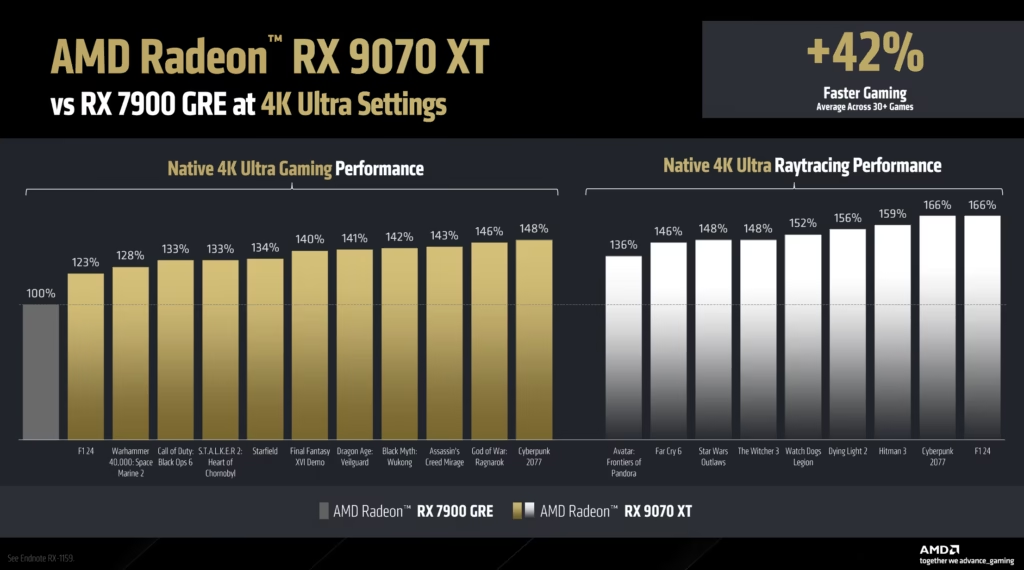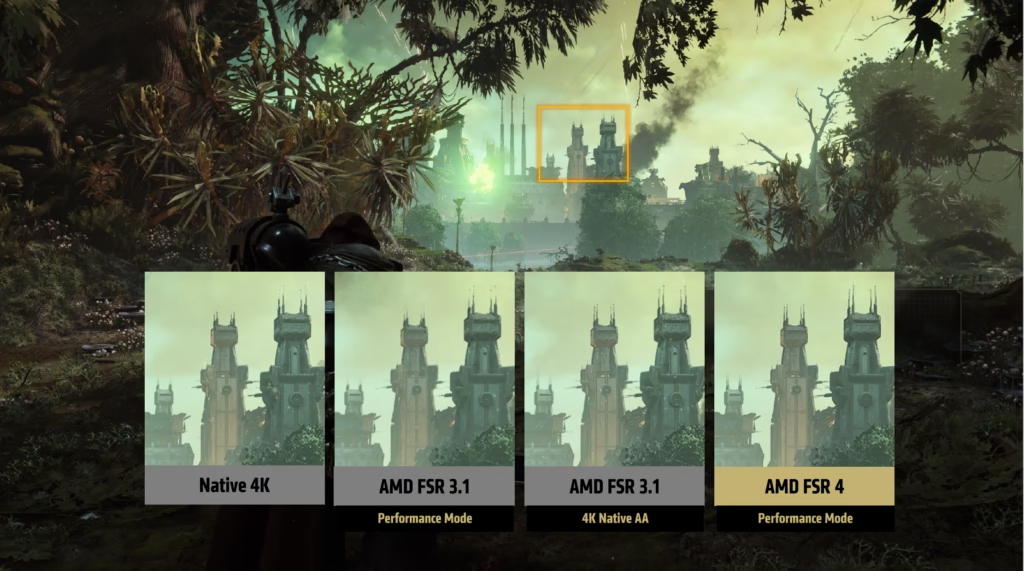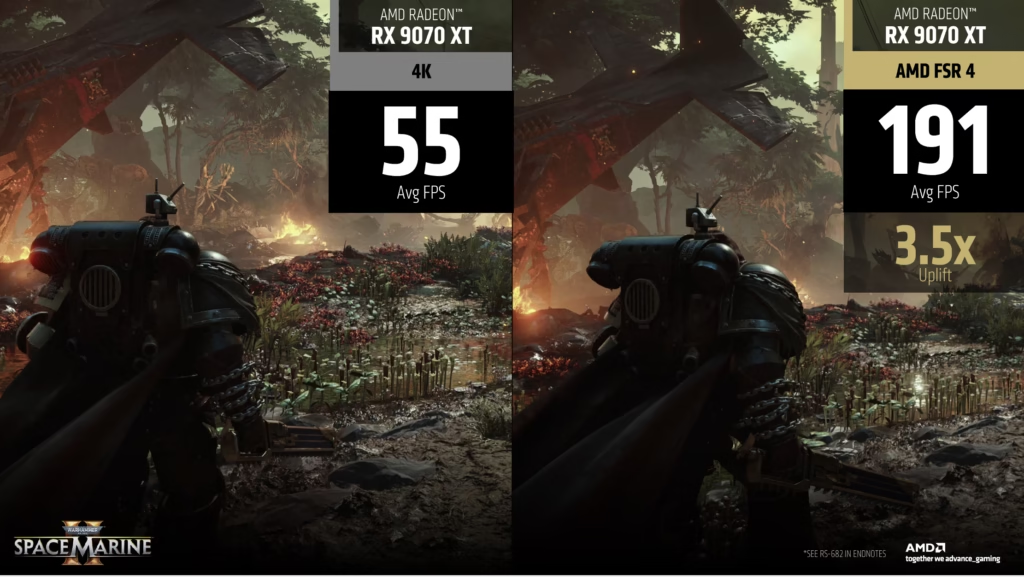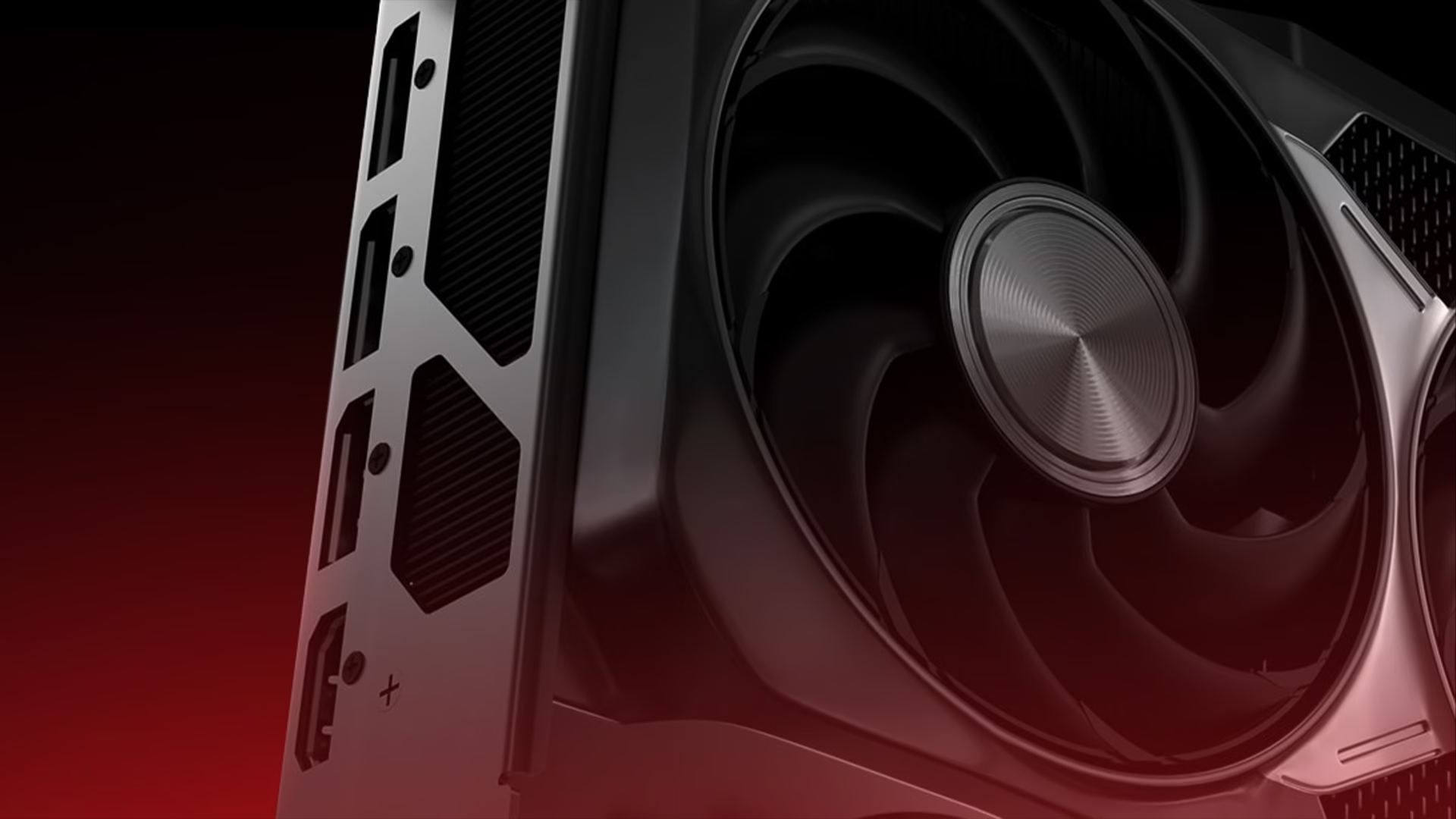The AMD Radeon RX 9070 and 9070 XT have a lot riding on their shoulders. These cards — set to go on sale on March 6 — promise to continue AMD’s tradition of offering great long-term value and give Nvidia a run for its money in the ray-tracing and upscaling departments.
AMD has slotted these cards between the 7900GRE and 7900XT in terms of pricing, but performance is expected to be superior. AMD’s internal estimates put the 9070’s performance at +20% over the GRE at 1440p (with and without ray-tracing), while the XT takes a 38% lead at 1440p and 42% lead at 4K. AMD also says that the cheaper 9070 is 38% faster than the 6800XT and 26% faster than Nvidia’s RTX 3080 (both GPUs are nearly five years old).
A more efficient architecture
As can be seen from the spec sheet (below), both cards offer 16GB of VRAM and are built around a new architecture called RDNA 4. AI performance also sees a big bump, and we’ll see why in a bit.
Note that the AI performance claims of AMD and Nvidia are not directly comparable as the metrics used for measurement are likely different.
| Model | RX 9070 | RX 9070 XT |
|---|---|---|
| RDNA 4 CUs | 56 | 64 |
| HW RT Accelerators | 56 | 64 |
| HW AI Accelerators | 112 | 128 |
| Peak AI TOPS | 1165 | 1557 |
| Boost Clock (GHz) | 2.52 | 2.97 |
| VRAM (GB) | 16 | 16 |
| TGP (W) | 220 | 304 |
| Interface | PCIe 5 x16 | PCIe 5 x16 |
The new RDNA 4 architecture introduces several significant updates, most notably to how ray-tracing and upscaling is now processed. The details are very technical, suffice it to say that ray-tracing should see a welcome 2x boost to performance per CU (compute unit) over the previous generation and AI should see a boost of 2x to 8x depending on the features being used.
The 9070 and 9070 XT both have fewer CUs (56 and 64) than either the 7900GRE (80) or the 7900XT (84), but have a broadly similar number of transistors. As AMD’s data indicates, however, that 2x boost to RT performance and other architectural updates — improved efficiency and performance, among other things — more than make up for the shortfall.

Just to highlight the gains that AMD is claiming with the new cards, AMD’s data indicates that the 9070 XT is 66% faster than the GRE at 4K Ultra settings in Cyberpunk 2077 with ray tracing set to Ultra. Theoretically, the new 9000 series cards should even outperform the flagship 7900XTX in the RT department. This is something we’ll be taking a closer look at in the review (coming soon).
Next-gen upscaling with FSR 4

Ray-tracing aside, the other big announcement with the 9000 series cards is FSR 4 aka FidelityFX Super Resolution version 4.
FSR is AMD’s term for its suite of upscaling techniques. When upscaling, the GPU renders a low resolution frame (say 1080p) and then scales it up (to say 4K) using various techniques. This gives the GPU more time to work on higher-quality effects such as ray-traced lighting.
This is great in theory, but when done badly, you’re left with an image that’s blurry and unstable, negating any benefit of higher quality visual effects.
Both DLSS 1 (Nvidia’s upscaler), and FSR 1 were awful. DLSS 2 and FSR 2 were much better but not always great, DLSS 3 and FSR 3 introduced frame-generation (inserting fake, AI generated frames between two real frames), and DLSS 4 and FSR 4 promise to vastly improve the quality of both upscaling and frame-generation. Unlike Nvidia, AMD has not introduced multi-frame generation tech alongside FSR4, and has instead focused more on visual quality and reducing latency.

Speaking from personal experience, our issue with AMD GPUs has always been visual fidelity in ray-traced titles and not necessarily raw performance. If FSR 4 adequately addresses the quality issue, AMD is sure to have a winner on its hands.
Improvements in FSR 4, thanks to AI
FSR 1 was a spatial upscaler that upscaled individual frames as they were rendered. This wasn’t very good. FSR 2 was a temporal upscaler that aggregated frame data over time to build a cleaner upscaled frame, but introduced other issues such as smearing and ghosting.
AMD says that the FSR4 upscaler (FSR 3 introduced frame-generation but used the FSR2 upscaler) now uses AI to scale up each frame more intelligently, resulting in a much superior upscaled image that’s closer to the quality of native resolution. You can think of this as neural upscaling. From the samples that AMD has shared, we can see that images upscaled via FSR 4 have a lot more detail and are much closer to native resolution. Given how FSR 4 works (using AI), it will be exclusive to AMD’s new 9000 series cards for now.
Improvements to FSR 4 upscaling should also impact the quality of frame-generation.
AMD says that 30+ games will have support for FSR 4 at launch, and that 75+ upcoming games will include support in 2025 alone. Supported games include Call of Duty Black Ops 6, Horizon: Zero Dawn Remastered and Forbidden West, Kingdom Come Deliverance II, the latest Spider-Man PC ports, Warhammer 40,000: Space Marine II, and more.
Other updates
The 9070 and 9070 XT are to feature updated media engines for higher quality, lower latency streaming and livestreaming. AMD also claims up to 34% improvement (versus the 7900GRE) in creator AI workflows such as denoising in Lightroom and Magic Mask Tracking in Resolve, up to 70% better performance when running generative AI models, improved support for ML frameworks and support for AMD optimised models, and more.
Pricing and availability
The AMD Radeon RX 9070 and 9070 XT will be available globally on March 6 at MSRPs of $549 and $599 respectively. At a guess, this would put India pricing in the Rs 55,000 to Rs 60,000 range.
If AMD can indeed deliver on its performance claims and ensure availability at these prices, the 9070 series could be the GPUs that save mid-range gaming PCs.


